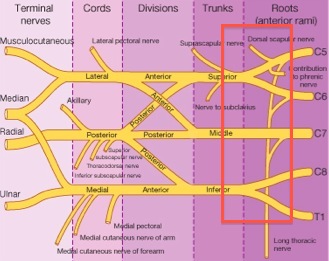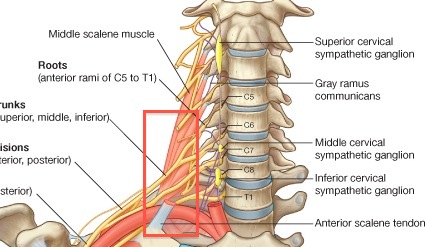A Prospective Comparison of Procedural Sedation and Ultrasound-guided Interscalene Nerve Block for Shoulder Reduction in the Emergency Department Acad Emerg Med. 2011 Sep;18(9):922-7 PMID 21883635
Not only do we have countless methods of reducing the shoulder, we now seem to be developing lots of ways of making the patient aware that we’re doing it.
This neat little study randomised 40 pts to either an US guided interscalene block with lignocaine/adrenaline or sedation with etomidate.
The guys doing it had attended a special course and had done at least 10 each of these blocks before the study began. So they’re a pretty skilled bunch of people.
The main outcome was time in the department and the nerve block won hands down (1.5hrs v 3hrs)
I fancy giving this a shot as setting up a procedural sedation is such a song and dance. Anything that I can get on with and do myself is always nice to have in the back pocket.
A brief review of the anatomy involved:
- the scalene muscles are a group of 3 lateral muscles (from vertebra to ribs) in the neck
- you’re looking for the space between anterior and middle scalene unfortunately also occupied by the subclavian artery so remember to use your doppler.
- NB the subclavian vein lies anterior to anterio scalene, as does the phrenic nerve.
- the glenohumeral joint has innvervation mainly from the posterior cord nerves but also from the suprascapular.
- the suprascapular has a high origin near the roots in the plexus hence the need to block so high up.
- there’s also a pesky lung apex nearby so be careful with the pointy thing in your hand…

As a brief thought, the Cunningham method shows us that the long head of biceps (the one that runs within the capsule across the superior part of the joint) is one of the main factors keeping the humeral head out of the glenoid fossa. If we could manage to paralyse biceps individually then that mught be enough to getting the shoulder in. Unfortunately the musculocutaneous nerve that supplies it isn’t always in the most consistent position when it pierces the muscle.



Find the brachial plexus just above the clavicle, just next to the subclavian artery, then trace it up the neck a bit. That’s the technique I use in Anesthesia.